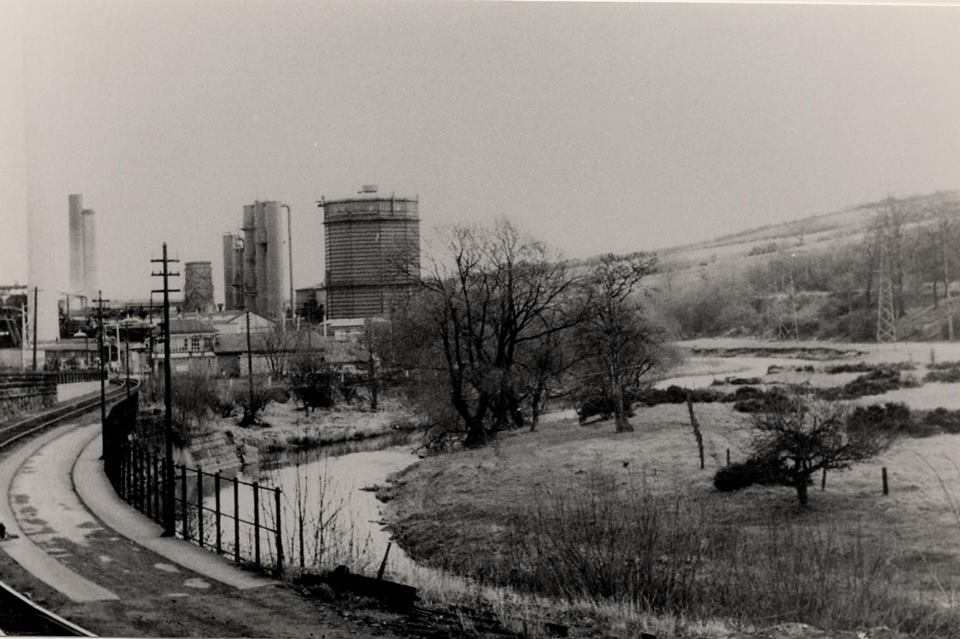In the 18th and 19th centuries, the site near Swalwell and Winlaton Mill had been that of Crowley’s Ironworks, which for a time was the largest ironworks in Europe. The coke works opened on the site in 1928. They were owned and operated by the Consett Iron Company.
The works was situated by the dam marking the upper tidal limit of the river, where Swalwell Juniors F.C. now stands. The CPP which washed and blended the coal prior to the coking process stood at the north-eastern end of the site, along with large storage bunkers. A conveyor fed blended coal from these bunkers into another bunker on top of the ovens which in turn fed the charging car. The ovens themselves were parallel to the A694, which passes the site, and stood on the area of land now occupied by the two football pitches. There were several railway sidings for both coal and coke between the ovens and the road. The pusher was on the opposite side of the ovens, and the coke was shoved out on the side nearest the road. The quenching tower was at the north-eastern end of the battery of ovens, near the CPP, and the chimney was at the opposite end. Between the ovens and the river were the power plant with its associated boilers and chimneys, as well as the by-products plant. The latter “scrubbed” the gas produced in the ovens, extracting chemicals such as tar and ammonia, which were piped into storage tanks. The gas was then stored in a tall gas holder to the south-east of the site, near the river.
There was a motive power depot nearby to house the locomotives which shunted the extensive network of NCB sidings and lines which served the works and the lower part of the Derwent valley. In the last few years of the works’ existence, these were all diesel locomotives, but prior to this there were a large number of steam locomotives stabled here. One of them, No. 41, was the oldest working NCB locomotive in the country, having been built for the Consett Iron Co. in 1883, by Kitson and Co. in Leeds, works No. 2509. It was of the Stephenson Long Boiler design, and unlike the ubiquitous 0-4-0 and 0-6-0 side tanks and saddle tanks which served most of the industrial railways of the
north-east, it was a pannier tank, (a layout common on the Great Western Railway, but rarely seen elsewhere). Prior to the demise of its fleet of steam locomotives, Derwenthaugh began to receive locomotives from other NCB sheds, either because they had closed, or the locomotive had become surplus to requirements. Nos. 7 and 59 were two such locomotives, easily identifiable as former NCB Lambton system residents from Philadelphia shed by their narrow curved cabs which allowed them to negotiate a tunnel with very limited clearances on the line to the docks at Sunderland.
Over the years the plant took coal from Chopwell Colliery, and in NCB days, from Marley Hill Colliery, via the nearby Clockburn Drift, as well as the opencast mines which operated in the area via the opencast disposal point at Swalwell. The last local deep-mined coal used at the plant came from the Victoria Seam at Sacriston Colliery near Durham. The coke produced was either sent directly to customers by rail, or shipped from a staithe on the River Tyne, which also had facilities for the storage and shipping of liquid tar and creosote produced at the works. When built, the works were fitted with turbo-alternators. Surplus electricity from the coke works was sent to Chopwell Colliery’s power station.Excess gas from the works was sold to the Newcastle and Gateshead Gas Company. Initially the alternators’ associated boilers were fired by waste gasses from the coking process, but in 1931 the boilers were converted to fire coal because
of an increase in demand for the gas from the Newcastle and Gateshead Gas Company
The works were closed in 1986 and the site was gradually cleared and de-contaminated. In addition to the football and tennis clubs on the site of the works itself, the surrounding land (which had been covered in spoil from the Clockburn Drift and waste from the coal-washing process) was cleaned up and landscaped, and is now the site of Derwenthaugh Park.

